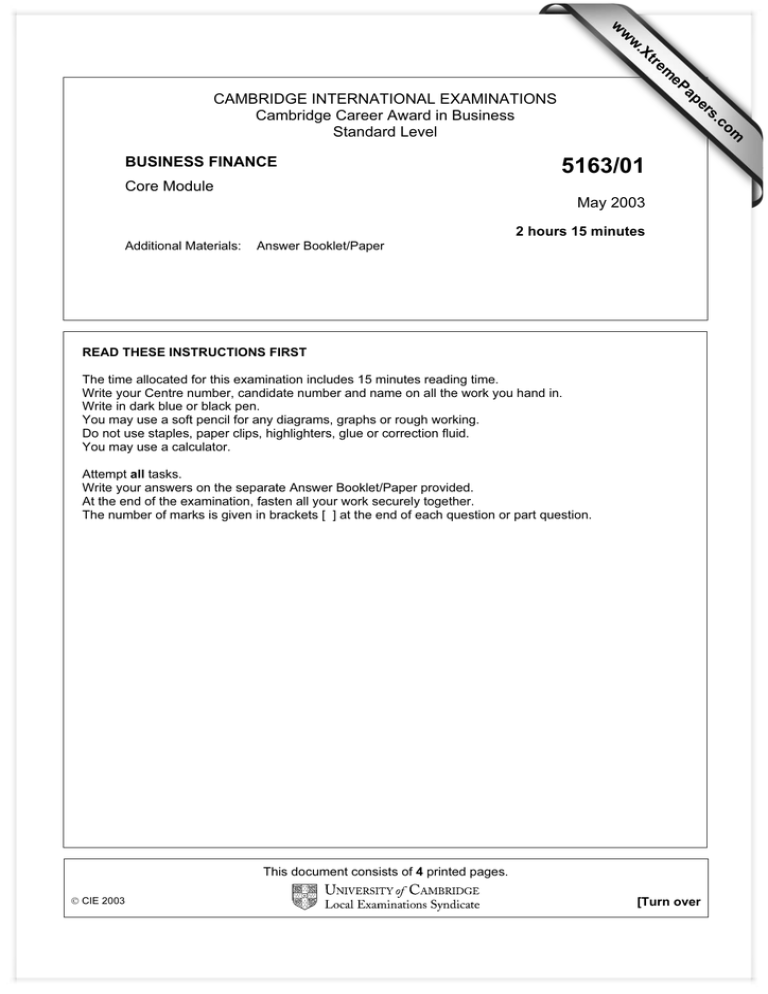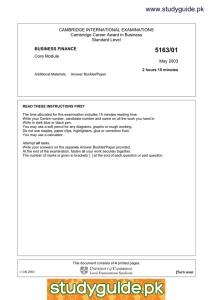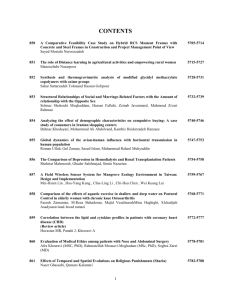5163/01 www.XtremePapers.com
advertisement

w w ap eP m e tr .X w Core Module om .c BUSINESS FINANCE s er CAMBRIDGE INTERNATIONAL EXAMINATIONS Cambridge Career Award in Business Standard Level 5163/01 May 2003 2 hours 15 minutes Additional Materials: Answer Booklet/Paper READ THESE INSTRUCTIONS FIRST The time allocated for this examination includes 15 minutes reading time. Write your Centre number, candidate number and name on all the work you hand in. Write in dark blue or black pen. You may use a soft pencil for any diagrams, graphs or rough working. Do not use staples, paper clips, highlighters, glue or correction fluid. You may use a calculator. Attempt all tasks. Write your answers on the separate Answer Booklet/Paper provided. At the end of the examination, fasten all your work securely together. The number of marks is given in brackets [ ] at the end of each question or part question. This document consists of 4 printed pages. Ó CIE 2003 [Turn over 2 You must read the case study below and attempt all the tasks that follow. The case study is fictitious. Case Study - Kahn’s Kasuals Hassan Kahn has been running the family clothing business for the last five years as a sole trader, employing eight of his relatives. The firm has managed to attract funding from the regional Government for expansion of the business. The firm makes some clothes for the domestic market but the recent growth has been in the production of copies of designer label clothing for exporting. The lack of any copyright laws in the 5 country makes this trade very profitable. Hassan is, however, aware that the business environment is changing in the following ways. · the National Government is coming under increasing pressure to introduce tighter copyright legislation. · the growth in the real income of the domestic population is becoming a significant factor 10 for the industry as a whole. · the National Government is proposing to introduce more complex accounting procedures in line with international standards. · it is rumoured that there is the possibility of a revaluation of the national currency in the 15 near future. Hassan has decided to contact his nephew, a product manager with a multinational company, for advice on future business strategy. His nephew has put forward a number of proposals for action. · the firm appears to be lacking capital, and Hassan should consider establishing a partnership or a limited company. · the accounting system employed by the firm needs to be formalised, employing standard 20 accounting concepts. (Hassan currently produces some figures at the end of each financial year.) · the machinery employed by the firm is becoming obsolete and needs replacing. The replacement machinery should be subject to a depreciation process. · Hassan should consider entering into a licensing agreement with the brand name 25 manufacturers rather than producing the present copies. This would require the purchase of new machinery. Hassan’s nephew has provided some financial information, some of which was extracted from Hassan’s records, for these proposals and has agreed to meet with Hassan in a month’s time. 5163/1/M/03 3 Financial Information Item A Owners Capital (including retained profits) Current Annual Turnover Current Gross Profit Margin $120,000 $600,000 20% Estimated Annual Turnover of Licensing Proposal Estimated mark up on cost price of sales Additional capital required for the proposal $900,000 20% $90,000 Item B Purchase of computerised design / cutting machinery $80,000 Maximum capacity of machinery per annum 80,000 units Sales revenue per unit $12.50 Variable cost per unit $9.31 Item C Balance sheet for Kahn’s Kasuals as at 30 April 2002 Produced by Hassan Khan – the balance sheet contains a number of errors. ASSETS Fixed $ Premises Vehicles Stock $ 90,000 20,000 15,000 125,000 Current Equipment Cash Retained profits 30,000 6,000 40,000 Creditors Loan Overdraft Debtors 23,000 11,000 2,000 30,000 76,000 201,000 LIABILITIES 66,000 35,000 100,000 201,000 Mortgage Owners Capital* *This figure calculated as a balancing item by Hassan Khan 5163/1/M/03 [Turn over 4 You must attempt ALL of the following tasks. 1 Explain what is meant by the following terms as used in the case study: (a) ‘copyright’ (line 5) [3] (b) ‘multinational company’ (line 16) [3] (c) ‘obsolete’ (line 23) [3] (d) ‘depreciation’ (line 24) [3] (e) ‘licensing agreement’ (line 25) 2 [3] [Total: 15] (a) Identify three of the external (PEST) factors referred to in the case study. [3] (b) Explain how each of the chosen factors could affect the future profitability of the business. [12] [Total: 15] 3 (a) Compare and contrast a partnership with a limited company. (line 19) [6] (b) List two advantages of either a partnership or a limited company compared to a sole trader. [4] [Total:10] 4 (a) Using all of the available information, produce a graph to show the break-even point associated with the proposal to purchase new machinery. [8] (b) Calculate the margin of safety associated with the estimated level of output. [4] [Total: 12] 5 Having identified the mistakes made by Hassan Khan and using all available information, produce a revised balance sheet, in appropriate format, for Khan’s Kasuals as at 30 April 2002. [18] 6 Identify and explain, using your own examples, the significance of four ‘standard accounting concepts’ as mentioned in the case study. (line 20/21) [16] 7 Using all available information, calculate the percentage change in the level of gross profit that would result from adopting the licensing proposal. [14] 5163/1/M/03




